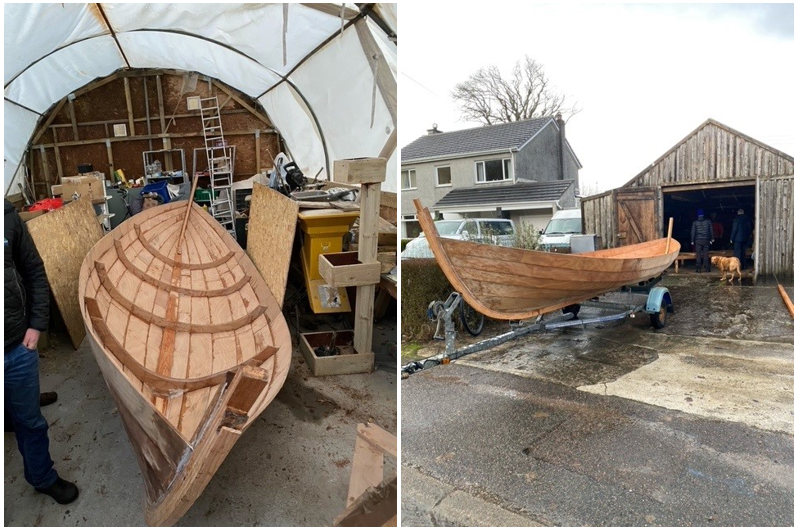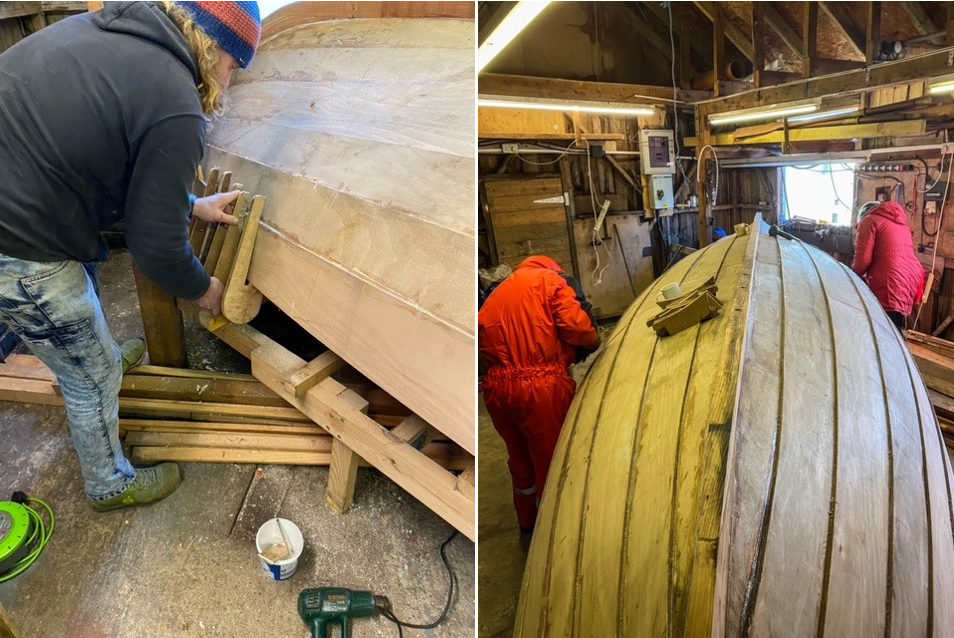Boat Building: Lochaber Coastal Rowing Club and the St Ayles Skiff Project

Nestled in the Scottish Highlands, where the untamed coastline greets the sea, the Lochaber Coastal Rowing Club thrives. This tight-knit community’s pivotal focus is rowing, but it extends beyond mere physical exertion. The club is equally fervent about forging connections and celebrating heritage.
“Lochaber Coastal Rowing Club was formed to promote and facilitate the sport of coastal rowing in the Lochaber area,” explains one of the club’s founding members. “The club was established to provide opportunities for people of all ages and abilities to participate in rowing, improve their fitness, and enjoy the beautiful coastal environment. We’re not just rowing; we’re connecting with each other and promoting the cultural and historical significance of the local maritime history in the area.”
We asked the club to divulge some specifics about their boat building journey. “We purchased a kit from Jordan Boats, specifically designed for the St Ayles. This kit was thoughtfully crafted to produce a bonny boat using comparatively easy construction methods. Even individuals with little or no boat-building experience could participate. Patience and a reasonable degree of practical ability were the key requirements.”
The club projected that a team of four or five people, dedicating their spare time after work and on weekends, could accomplish the construction within five to six months.
Operating within a stringent budget, this group of committed individuals began their journey to build a St Ayles Skiff. Unable to procure the complete boat-building kit, they chose the planking-only kit, available from the suppliers of the skiff kits for constructing second and subsequent hulls. “These contain the frames and planking only, and do not include the plans,” one member clarified. “However, we were gifted the construction frame and plans from another rowing group on the Black Isle, this was a great help.” This significantly alleviated their financial burden and provided a solid foundation for their project.
Construction Process
They initiated the construction process by assembling the frame and anchoring it to the floor of their workspace. Initially, they constructed the skiff upside down on the frame. After securing all the planks, they flipped the hull over to work on the interior. “The hull is built by assembling the plywood panels together using WEST SYSTEM®. The joints are permanently bonded with epoxy,” a member detailed the process.
Upon completion of the hull, the frame and seat installation commenced. They installed the frames, which lend structural support to the hull, at regular intervals along the length of the skiff. At this stage, they also installed the seats to accommodate the rowers. They typically fashioned both the frames and seats from plywood or solid wood.

Finishing Touches
After finalising the basic structure of the skiff, someone sanded it to achieve a smooth finish. They filled any imperfections or gaps with epoxy or wood filler. Then, they primed and painted the skiff with epoxy and marine-grade paint to shield it.
The concluding step was fitting out. A member equipped the skiff with oars, rowing seats, rudder, footrests, and other necessary fittings. “The rigging process involves attaching the oarlocks, thole pins, and other hardware components to the skiff. The oars are made from wood.”
The group is officially launching their Skiff on April 27th, 2024. Other skiff clubs in the highlands and islands are joining them to “come try out the rowing.”

Materials and Tools
To construct a St Ayles Skiff, the group employed a diverse array of materials and tools. Plywood was the material of choice for the hull and other structural components, owing to its strength and resistance to water damage. WEST SYSTEM Epoxy served as both a bonding agent and a protective coating for the wood.
Meanwhile, stainless steel fasteners securely assembled the various components of the skiff. The toolkit included essential tools such as a circular saw or jigsaw, handsaws, screwdrivers, drills, a hand plane, epoxy mixing tools, clamps, and finishing touches.
As for the specific WEST SYSTEM products, they were selected for their quality and reliability. “We discovered WEST SYSTEM products through recommendations from other skiff builders and online research. The reputation and their track record in the marine industry make them a trusted choice. The pump dispensing system is particularly effective and simplifies the process of achieving the correct ratios.”
Overcoming Challenges
The journey of building the St Ayles Skiff was not devoid of challenges. The group encountered setbacks due to the COVID-19 pandemic, which resulted in a loss of momentum in the project. Additionally, building the skiff in a polytunnel presented issues with temperature control.
Material availability was another hurdle. At times, certain materials and tools required for building the skiff were not available. For instance, the group found themselves short of clamps but managed to borrow some from another Skiff Rowing Club.
Design modifications also posed challenges. While constructing the skiff, the group encountered design flaws or areas that needed modification. “Fitting some of the planks can present challenges during installation.” a member shared. However, advice from other people who had constructed skiffs proved invaluable.

Time and financial constraints were other significant challenges. Building a skiff is a time-consuming process, and unexpected setbacks can further delay completion. The group overcame these constraints by planning the construction process, allocating sufficient time for each task, and preparing for unforeseen delays. Breaking down the project into smaller, manageable tasks was a helpful strategy.
Financially, skiff making can involve some costs, and unexpected expenses can strain the budget. The group had to be creative in finding solutions. “For example, not buying the full skiff building kit, using frames from other projects and just buying the cheaper kit helped make our skiff more affordable for us to build.”
Despite these challenges, the group found the key to overcoming unexpected setbacks was to approach them with a problem-solving mindset, seek support and guidance when needed, adapting to the situation by making necessary adjustments. This happened, for example, when storms badly damaged the polytunnel, forcing them to move mid-build to another shed.
The Role of Volunteers
Volunteers, who play an indispensable role in the operations and progress of the project, entirely run the Lochaber Skiff Building Project. They contribute their time, skills, and expertise to help build the skiff and will maintain it once completed.
Various tasks such as carpentry, painting, varnishing, sanding, and general maintenance involve volunteers. They work alongside Chris, one of the founding members of the club, who is a furniture maker and boat builder. This collaboration provides them with the opportunity to learn valuable skills.

Skill Development Opportunities
The project offers skill development opportunities to its participants. Firstly, volunteers have the chance to learn traditional boat building techniques and gain practical skills in woodworking and craftsmanship. They learn how to use equipment, understand different types of wood, and develop their problem-solving abilities.
Secondly, the project provides opportunities for participants to develop teamwork and communication skills. Working together on a shared goal, volunteers learn how to collaborate effectively, communicate their ideas, and coordinate their efforts.
Lastly, the project offers a chance for personal growth and self-confidence. Volunteers gain a sense of accomplishment from seeing their hard work materialise into a tangible product. This experience also instils a sense of pride and responsibility in the project.
In essence, the Lochaber Skiff Building Project transcends the mere act of building a boat. When a group of dedicated individuals come together with a shared vision and purpose, it indicates what can be achieved.
“The project has given community members a sense of ownership and pride in their skiff,” one participant shared. “By actively participating in the construction and maintenance of the skiffs, individuals feel a strong connection to the project and take honour in it.”
Looking ahead, the community harbours exciting plans for the future. They aspire to build another skiff and regularly travel for rowing sessions with different clubs in the local area. “We aim to regularly travel to have rowing sessions with the various clubs that surround us. For example, Glencoe, Isle of Seil, Appin, Lochaline.”
For other community groups considering a similar boat-building project, the participant offered some advice. “Clearly define the purpose and goals of your project. Determine what you hope to achieve and how the project will benefit the community,” they suggested. They also emphasised the importance of assembling a diverse team, encouraging community involvement, seeking guidance from experienced boat builders, documenting and sharing the process, celebrating the completion, and planning for the boat’s maintenance with sustainability in mind.
“Remember, a boat-building project is not just about constructing a vessel. It’s an opportunity to bring people together and create a lasting impact.”
Find your nearest WEST SYSTEM Stockist here!

Have you subscribed to our FREE monthly newsletter? Sign up here!
Working on a project? Share it with us! Click here…
